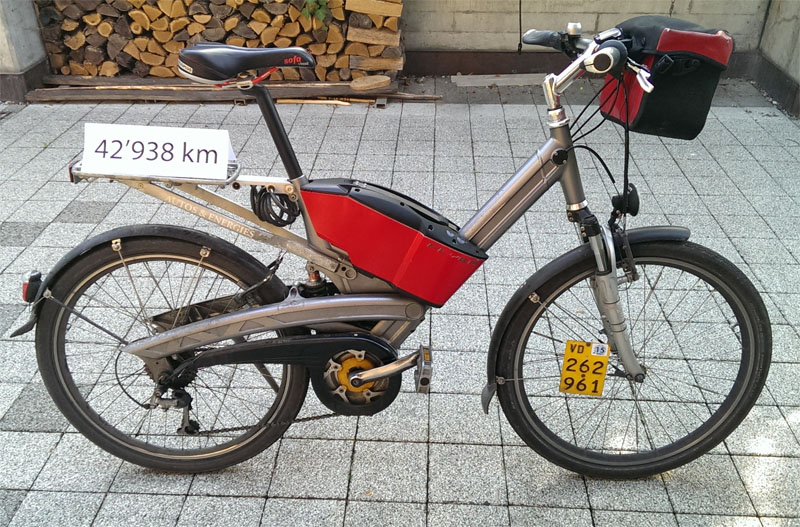|
|
|
|
|
|
| |
|
|
|
|
| Links |  |
Mobility and environment
Homepage of Francesco Mondada
A simple but interesting comparaison
Nowadays mobility is very important. We are used and culturally need to move around a lot for business, for shopping or in free time. But we have to be very careful about HOW we move. The choice of the transportation method can change not only how fast we reach the goal location, but also the impact of our displacement on the environment. Classical choices are cars, trains or airplanes but we have also to consider going by foot or by bycicle. Just to have an idea of the consumption:
| Type of transportation | Energy/km | Energy for 10 km per person | Time needed for 10 km | Time needed for 1000 km |
| By foot | 15 Wh/km | 150 Wh | 2 hours | one month |
| By bicycle | 3 to 7 Wh/km | 50 Wh | 30 minutes | one week |
| By car (one to five persons) | 100 to 250Wh/km | 800 Wh |
10 minutes | 10 hours |
| By plane (one person) | 150 to 200 Wh/km | 1750 Wh | - | 4 hours |
| By train (one person) | 25 Wh/km | 250 Wh | 6 minutes | 7-8 hours (4-5 with high speed trains) |
NB1: This table gives just an idea, it's not the final
comparaison. Not all cars are the same (!, see link above for more on
this).
NB2: Some friends asked to me to add motorcycles to this tables. I never
found reliable data on them, but it seems that the technology available
on modern cars is much better than the one available on motorcycles.
As result motorcycles are in some cases more polluting than a car, even
if they are lighter and with less fuel consumption. I have just one
document on this, I will try to bring new data on this soon. Feedback
welcome!
The two most interesting comparaison are car-bicycle for short distances and plane-train for medium-long distances.
Planes need 7 times more energy than trains but are only twice faster. If you add the fact that most trains are powered electrically and planes with fuel, the global balance is very bad for the plane and very good for the train. Think about this when moving around next time for short (airplane) distances.
It is also very interesting to see that for short distances the car needs about 16 times more energy for just 3 times shorter time than bicycle, which is a bad performance. The high energy is mainly needed to carry around a ton of equipment/structure for confort and protection to rain, but this is still a very high price, even non considering the much higher pollution generated by the car. If you add the fact that most people travel alone for short distances, the comparaison is really very bad for the car. So please think about this before taking a car for a short distance. You could do your fitness exercices during the displacement, saving enery, pollution, money for the transportation ... and for the fitness center!
My personal choice: the electrical bicycle
Several small progresses have been made on cars, trains and airplanes. A very nice progess have been made, in my opinion, in electrical small vehicles such as scooters or bicycles. This generates a new type of mobility very well adapted to short and very frequent displacements.
In my case (a family with 3 childrens, many displacements for the family and 10-25km per working day of displacement to go to work) the car is necessary. But short and daily displacements with one person (me) represent nearly 2-4'000 km per year, i.e. one third of all displacement, which is a lot. So I decided to make at least this part in a cleaner way, without the car. In the past I used several year the bike for travelling between home and work, but I was not ready to make this again, having more distance to cover in my new sitiuation (I wanted to be able to return home at noon with my family, which makes 25km/day in very uneven terrain, and now I get older and do not get back home at noon, but cannot afford to make 45 minutes by bike).
The solution I found is the electrical bicycle. It helps in reducing travel time and improving confort using "clean" power, keeping the advantages of a bike (parking etc) and also some disadvantages (weather influence, for instance).
This graph shows the statistics I collected on our car usage and the influence of the use of the electrical bike:

We got our first family car after our first child, Luca, in 1997. We started using it a lot, even if not as much as the swiss average. As a comparison, the average daily distance covered by car in Switzerland by person is 27km. The car use has been constant until 2001. At this time our two children were sufficiently old to make it possible to use the train in a more confortable way (less equipment needed in holidays for instance). When Leonardo arrived in 2002 we started to use the car again, but I started also to use the electrical bike to go at work. This helped to keep a low car usage even if performing many displacements. In 2011 our car usage dropped drastically, because the car was not used anymore for displacements to work. Never been so low, great news!
Why my use of the bike decreases in 2006 and 2007 and increases again in 2008? In 2006 I had 2 months without bike because of a major revision of the bike and several problems. During 2006 I had to replace a lot of parts (battery, front fork, rear wheel and a lot of accessories). I started in 2007 with a nearly new bike.... and had an accident end of January. Most of the front part of the bike has been replaced, the battery electronics too. I had to stay without bike for several months too. In 2007 we had also a reduction of car use mainly because Luca stopped the basket training in Morges (two long displacements every week). In 2008 we started new activities with the kids and I could better use my bike again. In 2009 we had tent holidays in France with a dimplacement of 2000 km by car, increasing the car usage average. In 2010 we had no big car displacements during the sommer, going back to the previous average. I made less kilometers by bike, mainly due to some repair and to a long period with snow (dangereous by bike). In 2011 my bike usage dropped a little bit, mainly because of an accident (not with the bike) I had. I broke my shoulter and could not use the bike for nearly 4 months. Since 2012 I changed a bit my schedule, going less at home for lunch, and decreasing also the number of kilometers with my bike. In 2015 the manufacturer of my bike (Flyer) stopped supporting my old bike and made me an offer to buy a new one. Therefore I changed my F6 bike:

This bike was in use 13 years, did nearly 43'000 km for only 100 swiss francs of electricity!
I have now a new bike, always from Flyer, a model TS15 7.70:

I got this new bike during my sabbatical year in Graz, but as Graz is flat, no need for it. I used a standard bike that is not in my stats. This is the reason of the low number of km in 2015-2016. I planned to be back to full usage in 2017, but I was sick for several months, not able to use the bike again as planned. In 2018 I could use fully my bike, reaching again an average of 8.8 km/day. With a broken arm in 2019 my usage of the bike was a bit lower, and 2020 has been the COVID year, therefore with a lower usage of bike. But also the usage of our car was never so low! In 2021 we had a big issue with the car and as the replacement parts were impossible to find, the car stayed 7-8 months in the workshop waiting for the parts. This explains the low number of kilometers. We used others cars but this was harder to monitor. Probably the real number of kilometers by car is similar to the previous year. Then we started again using the car, including some lessons for driving licenses and some (far) relocations. In 2024 we got back to very rare use of the car, reaching the lower average per year just after COVID times.
For more information (links):
- If you really need a car (as I need for my family) please check first the list published every year by ATE/VCS and comparing all available car on the markets about pollution. In this publication (in french) you find a lot of useful information on buying a car, included the ratings of all car producers, comparaison gaz/fuel etc. I am of course ATE member.
- Car sharing is an interesting alternative to the private car or a nice complement when travelling far away. Car sharing is very well developed in Switzerland by the company MOBILITY. I am of course a MOBILITY member.


